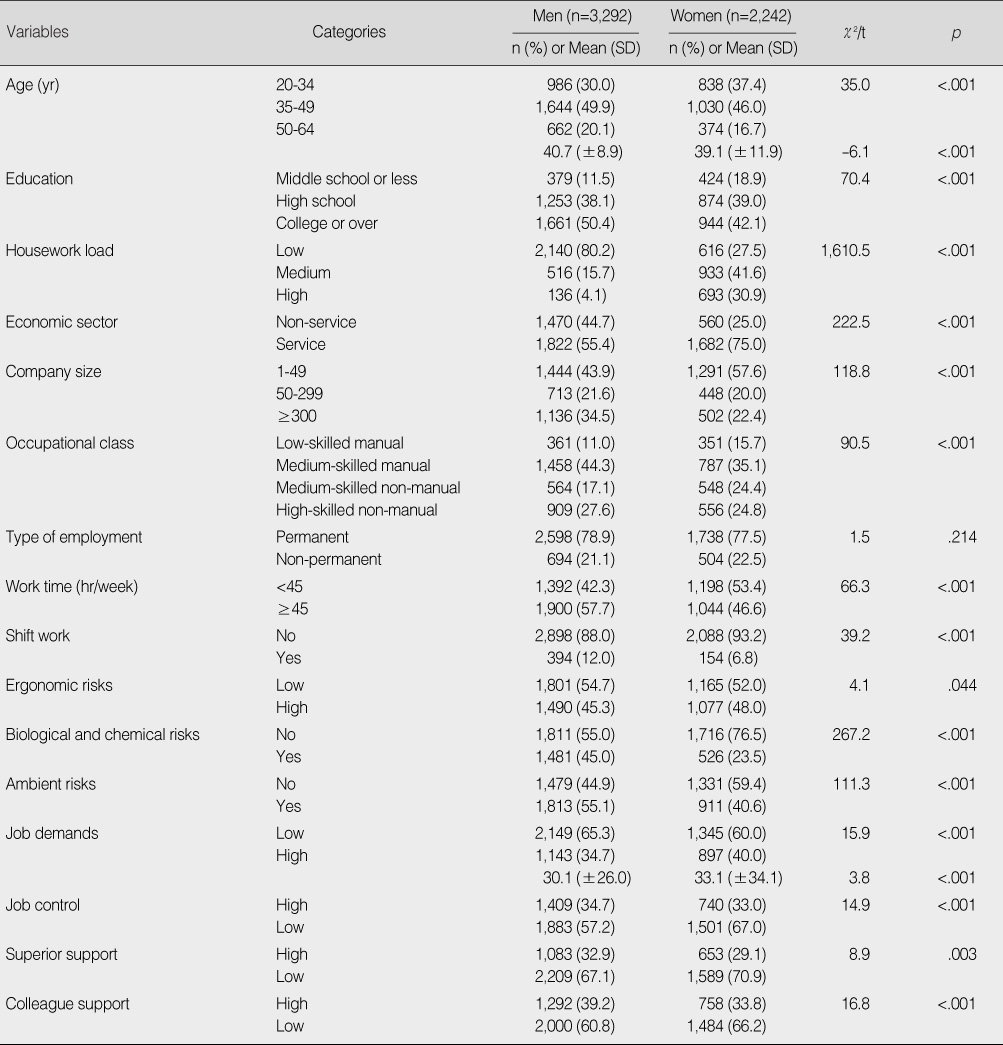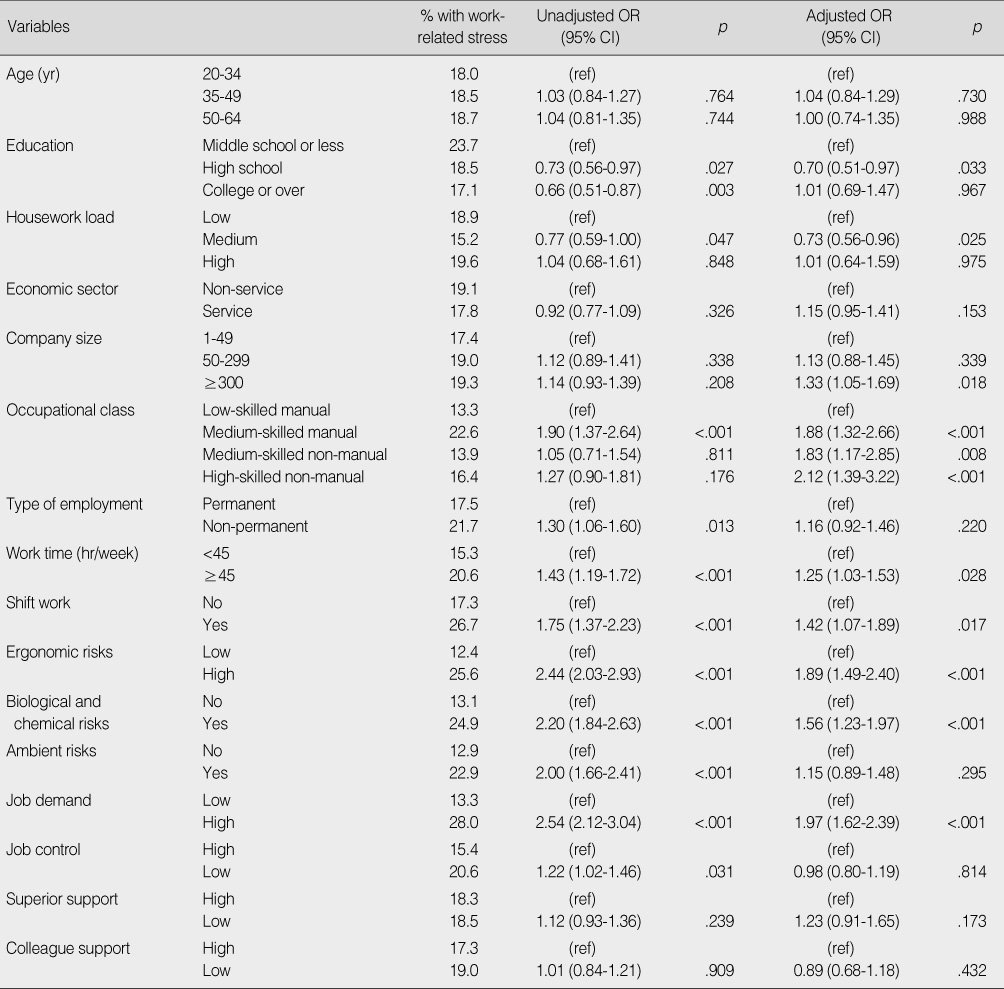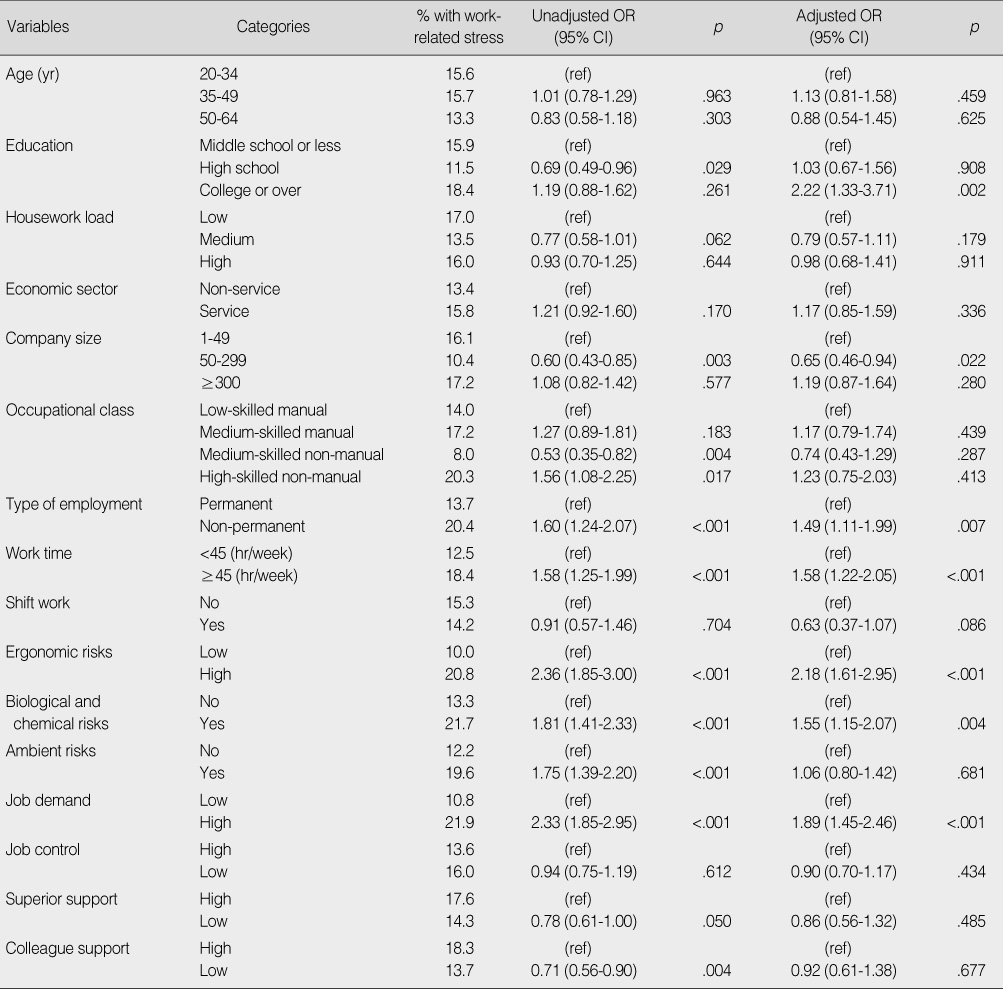Articles
- Page Path
- HOME > J Korean Acad Nurs > Volume 39(4); 2009 > Article
-
Original Article
- Work-related Stress and Risk Factors among Korean Employees
- Eun Sook Choi, Yeongmi Ha
-
Journal of Korean Academy of Nursing 2009;39(4):549-561.
DOI: https://doi.org/10.4040/jkan.2009.39.4.549
Published online: August 31, 2009
1Full-time Lecturer, The Institute of Nursing Science, College of Nursing, Kyungpook National University, Daegu, Korea.
2Doctoral Student, School of Nursing, University of North Carolina at Chapel Hill, NC, USA.
- Address reprint requests to: Ha, Yeongmi. School of Nursing, University of North Carolina at Chapel Hill, Carrington Hall, Campus Box 7460, Chapel Hill, NC 27599-7460, USA. Tel: 919-943-0262, Fax: 919-966-7298, ha@email.unc.edu
• Received: March 11, 2009 • Accepted: July 23, 2009
Copyright © 2009 Korean Society of Nursing Science
Figure & Data
REFERENCES
Citations
Citations to this article as recorded by 

- The Effect of Occupational Stress on the Psychological Well-Being of Healthcare Workers: Basis for Stress Management Interventions
LOVELY V. ECHALAR
International Journal of Innovative Science and Research Technology (IJISRT).2024; : 391. CrossRef - The association between nutrition label utilization and disease management education among hypertension or diabetes diagnosed in Korea using 2018 Community Health Survey: a cross-sectional study
Miran Jin, Jayeun Kim, Kyuhyun Yoon
Korean Journal of Community Nutrition.2023; 28(1): 38. CrossRef - Associations of extended work, higher workloads and emotional work demands with sleep disturbance among night-shift workers
Bo Min Jeon, Su Hyun Kim
BMC Public Health.2022;[Epub] CrossRef - Psychological stress, smoking, and hazardous drinking behaviors in South Korea: findings from the Korea National Health and Nutrition Examination Survey
Hyunjoon Lee, Harold H. Lee, Augustine Kang, Yoojin Cha, Don Operario
Journal of Substance Use.2021; 26(1): 13. CrossRef - Job Stress and Cardiometabolic Lifestyle Modification Behaviors Among Workers in High-risk and Low-risk Workplaces
Jiyeon Jung, Jina Choo, Sooyeon Park, Jihyun Moon, Songwhi Noh
Journal of Occupational & Environmental Medicine.2021; 63(6): e346. CrossRef - Sex and Gender Differences in Occupational Hazard Exposures: a Scoping Review of the Recent Literature
A. Biswas, S. Harbin, E. Irvin, H. Johnston, M. Begum, M. Tiong, D. Apedaile, M. Koehoorn, P. Smith
Current Environmental Health Reports.2021; 8(4): 267. CrossRef - Effects of a Yoga Program in Reducing Cardiovascular Disease Risk Factors in Workers of Small Workplaces: A Pilot Test
Won Ju Hwang, Jin Ah Kim, Ji Sun Ha
Sustainability.2020; 12(23): 10038. CrossRef - Impacts of family status and gender on the relationships between job demands, job control, and distress
Sehoon Kim, Hyounju Kang, Boreum Ju
European Journal of Training and Development.2019; 43(3/4): 322. CrossRef - Relationship between stress-related psychosocial work factors and suboptimal health among Chinese medical staff: a cross-sectional study
Ying-Zhi Liang, Xi Chu, Shi-Jiao Meng, Jie Zhang, Li-Juan Wu, Yu-Xiang Yan
BMJ Open.2018; 8(3): e018485. CrossRef - Association of stress, depression, and suicidal ideation with subjective oral health status and oral functions in Korean adults aged 35 years or more
Young Sun Kim, Han-Na Kim, Jung-Ha Lee, Se-Yeon Kim, Eun-Joo Jun, Jin-Bom Kim
BMC Oral Health.2017;[Epub] CrossRef - Mediating Role of Psychological Capital in Relationship between Occupational Stress and Turnover Intention among Nurses at Veterans Administration Hospitals in Korea
Hee-Yun Yim, Hyun-Ju Seo, Yoonhyung Cho, JinHee Kim
Asian Nursing Research.2017; 11(1): 6. CrossRef - Association between supervisors’ behavior and wage workers’ job stress in Korea: analysis of the fourth Korean working conditions survey
Shin Uk Kang, Byeong Jin Ye, ByoungGwon Kim, Jung Il Kim, Jung Woo Kim
Annals of Occupational and Environmental Medicine.2017;[Epub] CrossRef - Association of Job Stress with Health-promoting Behaviors and Health Status in Clinical Nurses
Jung-Suk Kim, Chun-Ja Kim
Korean Journal of Occupational Health Nursing.2016; 25(4): 311. CrossRef - The psychosocial status of the family members of rheumatoid arthritis patients in Korea
Sang Wan Chung, You Jung Ha, Eun Ha Kang, Yun Jong Lee, Yeong Wook Song
Rheumatology International.2016; 36(5): 719. CrossRef - A Study on the Characteristics of Injured Workers Rate and Work Environment of Male Workers for over 40 years
Kil-Yong Choi, Kyung-Soo Yang
The Korean Journal of Health Service Management.2016; 10(1): 131. CrossRef - Effects of an internet-based lifestyle intervention on cardio-metabolic risks and stress in Korean workers with metabolic syndrome: A controlled trial
Chun-Ja Kim, Elizabeth A. Schlenk, Se-Won Kang, Jae-Bum Park
Patient Education and Counseling.2015; 98(1): 111. CrossRef - A Comparative Study on Job Satisfaction of Road Freight Transportation Industry Workers by Type of Employment
Heon Jong YOO, Seung Bum AHN
Journal of Korean Society of Transportation.2015; 33(4): 368. CrossRef - Effect of Obesity and Psychological Stress on Oral Health
Soo-Hwa Kim, Sun-Mi Lee
Journal of dental hygiene science.2015; 15(2): 119. CrossRef - Association Night-Shift and Long Working-Hours Effects on Subjective Insomnia in Korean Workers: The Third Korean Working Conditions Survey
Chae-Bong Kim, Tae-Young Jung, Seoung-Min Han
The Korean Journal of Health Service Management.2015; 9(1): 41. CrossRef - Under and Over Employment and Working Conditions
Kyung Yong Rhee, Se Wook Song, Young Sun Kim
Journal of Korean Society of Occupational and Environmental Hygiene.2014; 24(4): 536. CrossRef - Prevalence and Associated Risk Factors of the Metabolic Syndrome in the Korean Workforce
Dae Ryong KANG, Yeongmi HA, Won Ju HWANG
Industrial Health.2013; 51(3): 256. CrossRef - Health Status and Affecting Factors related to Job among Korean Women Employees
Eun-Young Hong, Sang-Dol Kim
Journal of the Korea Academia-Industrial cooperation Society.2012; 13(9): 4107. CrossRef - Influence of task demands on occupational stress: Gender differences
Susana García Herrero, Miguel Ángel Mariscal Saldaña, Javier García Rodriguez, Dale O. Ritzel
Journal of Safety Research.2012; 43(5-6): 365. CrossRef - Analysis on Stress and Dietary Attitudes of Male Employees
Mi-Ae Lee, Eun-Ju Lee, Hye-Kyung Soh, Bong-Soon Choi
Korean Journal of Community Nutrition.2011; 16(3): 337. CrossRef - Spirituality and Stress Responses in Small Industry Employees
Sook Lee
Journal of Korean Academy of Psychiatric and Mental Health Nursing.2010; 19(2): 220. CrossRef - Health Behaviors by Job Stress Level in Large-Sized Company with Male and Female Workers
Hyunju Park, Hye-Sun Jung
Journal of Korean Academy of Nursing.2010; 40(6): 852. CrossRef
Work-related Stress and Risk Factors among Korean Employees
Work-related Stress and Risk Factors among Korean Employees
Characteristics of Korean Employees aged 20-64 yr by Gender
Unadjusted Odds Ratios (OR) and Adjusted Odds Ratios (OR) for Work-related Stress as Dependent Variable and the Risk Factors as Independent Variables among Korean Employed Men (N=3,292)
Unadjusted Odds Ratios (OR) and Adjusted Odds Ratios (OR) for Work-related Stress as Dependent Variable and the Risk Factors as Independent Variables among Korean Employed Women (N=2,242)
Table 1
Characteristics of Korean Employees aged 20-64 yr by Gender
Table 2
Unadjusted Odds Ratios (OR) and Adjusted Odds Ratios (OR) for Work-related Stress as Dependent Variable and the Risk Factors as Independent Variables among Korean Employed Men (N=3,292)
Table 3
Unadjusted Odds Ratios (OR) and Adjusted Odds Ratios (OR) for Work-related Stress as Dependent Variable and the Risk Factors as Independent Variables among Korean Employed Women (N=2,242)
 KSNS
KSNS
 E-SUBMISSION
E-SUBMISSION



 Cite
Cite

